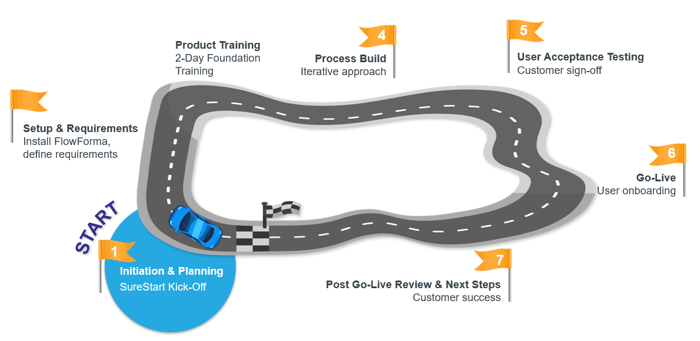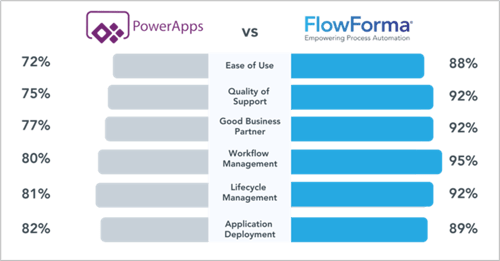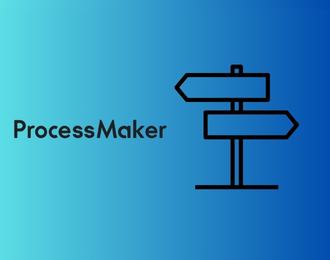Digitalization, transformation, and business process automation are all buzzwords which we have become accustomed to in recent years. But what do all these terms actually mean for organizations and what are the business outcomes of Business Process Automation?
These are often daunting words which indicate a lengthy, challenging project that scraps legacy systems/investments, requires lots of time, resources and budget. However, this is not always the case.
In reality, some manual tasks will always exist, but leading companies are reaping the benefits of Business Process Automation and are transforming the way they work to stay competitive, reduce costs and ensure compliance by implementing Business Process Automation tools and comprehensive digitalization software.
Let’s break down the key questions around Business Process Automation and why your organization needs to embrace it.
Quick Links 🔗:
- Why should I digitalize my business processes?
- How do I prioritize which business processes to digitalize?
- How quickly can I digitalize my processes?
- Are digitalized processes quicker than traditional processes?
- What are the benefits from digitalizing business processes?
- Who benefits from digitalizing business processes?
- Can I make changes to a process once it’s digitalized?
- Do I need technical expertise to digitalize processes?
Why should I digitalize my business processes?
Implementing a Business Process Automation tool may sound scary, but once you get through the change the resulting efficiencies and value will quickly pay off as you gain an edge over your slower-moving competitors.
At FlowForma we know that one of the many challenges currently faced by businesses is a skills shortage and/or being ‘stuck’ with expensive solutions that are already in place.
These challenges can also impact each other. For example, you have a solution, but you don’t have the skills required to utilize it to its full potential or vice versa. Alternatively, it could be that perhaps you already have a Robotic Process Automation (RPA) solution in place, which digitalizes repetitive tasks however, you have a long list of people-driven processes, that need to be streamlined that RPA can’t assist with.

The biggest drawbacks of repetitive manual processes is time, cost, and inefficiencies as well as the inability to identify bottlenecks in processes. IT departments are tasked with providing leaner systems but are constantly challenged by budgets, skills shortages, and bandwidth which often results in process automation requests being sent to the bottom of the task list or deprioritized.
Our webinar recording with research experts, Forrester, illustrates why organizations need to invest in a no code Business Process Automation tool now - to ensure process transparency, speed, and agility.
Organizations need to address process inefficiencies to remain competitive, grow, and be successful. It’s not just the obvious business goals that benefit from a Business Process Automation solution, but also staff morale and customer satisfaction are a direct outcome.
If internal and external customers are happy it is a huge plus for any organization. Efficient workflows benefit everyone from the bottom up. People will want to work for you and with you when you have consistent processes in place.
The downside of not digitalizing processes:
- Inconsistent processes and procedures leave room for error and misinterpretation.
- Inaccurate data can lead to poor decision-making.
- Non-compliance due to manual processes not being completed, recorded, or stored accurately.
- Unnecessary overheads caused by poor workflow management and cumbersome manual tasks.
- Lost revenue caused by project overruns/inability to identify bottlenecks.
- High attrition rates linked to poor employee experience from repetitive manual tasks within an organization.
In a time when margins are tight, time is money, skills are stretched to the limit, and soaring costs it is a no-brainer that Business Process Automation can no longer be put on the long finger!
How do I prioritize which business processes to digitalize?
Like any tech project, it is often difficult to know where to start. But the pain of change is less than the pain of staying the same.
As an organization you know you need to be more efficient, you know Business Process Automation will help but you have an extensive list of processes you want to digitalize and it is difficult to identify where to start.
 Appoint a Process Champion
Appoint a Process Champion
Newly digitalized processes or new ways of working require buy-in and senior-level support. It is highly recommended to appoint an internal champion, the more senior the better.
With a Business Process Automation champion in situ, a plan can be put in place to communicate the initiative, identify obvious processes for digitization, training, and a strategy for automation – this approach results in rapid adoption and success rates.
By appointing a champion of your Business Process Automation efforts, it will also help ensure that you have the funding and resources you need at your disposal.
Your champion must clearly understand what is needed to be successful; your job is to communicate the resources that you need, the barriers that stand in your way, and the people that must be enlisted to make your project a success.
Identify Painful Processes
Do not be over ambitious. Your natural reaction is to start with the process that is causing the most pain but also weigh that up against which process could be automated in the shortest timeframe. Getting buy-in is key so, if you can, establish which simple process is painful and extremely time-consuming. Time to value is a key benefit of business process automation. Prove how quickly you can see results and use the first process as a benchmark for your first automated process success story. In many instances, the template used for that process can be replicated across many other workflows with tweaks here and there depending on rules.
 Download FlowForma’s 6-step guide on best practises for implementing a Business Process Automation tool.
Download FlowForma’s 6-step guide on best practises for implementing a Business Process Automation tool.
Taking small steps is key to achieving success and then scaling at pace. Organizations will encounter the FOMO effect of their peers. The HR department might successfully automate a simple process such as PTO/leave requests, then the Finance team learn about efficiencies gained on the grapevine. The data transparency, consistent approach etc. may help to visualize how other time-intensive processes within their team could adopt a similar approach e.g. PR approval/expense management. Transformation must take place in an agile way led by the people in the business domain.
With the correct Business Process Automation tool the opportunities are endless and the beauty of it is that it can be used within any industry for common business paper-intensive tasks.
How quickly can I digitalize my processes?
A no code business process automation tool, such as FlowForma Process Automation, minimizes the costs upfront. Professional services, IT services, and consultancy fees are negligible, and businesses can start generating ROI in a matter of weeks.
FlowForma's SureStart onboarding program is designed to enable new customers to automate their business processes quickly and easily, using our unique no code process automation tool. With the support of our process experts, we help you deliver your first business process live within 4 to 6 weeks.
The program is designed to rapidly onboard and empower you to digitalize your business processes at speed, we:
- Support you in digitalizing your 1st business process within 4 to 6 weeks
- Enable your business users to quickly become self-sufficient, ready to digitalize processes
independently - Provide ongoing coaching, best practice advice, and guidance throughout
- Empower you to drive adoption across the business for greater ROI
The SureStart Track:

Additionally, FlowForma have created a set of fully customizable process templates to help get users up to speed fast, these include:
- Incident management
- Risk assessment
- New employee/supplier onboarding
- Tender Evaluation
- Change request
- Project approval
- Project change
- Purchase requisition
- HR
- Capex Request
- Expenses
- and more…
Learn how Dresser Natural Gas Solutions completed their first digitalized process in just 30 days, with subsequent flows taking just two days to build, test, and launch.
 “We had 4-6 months to replicate what we had before and needed a process automation tool that we could implement quickly due to the time constraints.”
“We had 4-6 months to replicate what we had before and needed a process automation tool that we could implement quickly due to the time constraints.”
- Imelda Bettinger, SharePoint Developer, Dresser Natural Gas Solutions.
Dresser Natural Gas Solutions case study 💡
Are digitalized processes quicker than traditional processes?
Business process automation tools expedite task completion, resulting in faster turnaround times for vital processes. By replacing manual tasks with automated ones, these tools eliminate delays associated with human intervention, ensuring processes are completed swiftly and efficiently.
BPA software can trigger immediate responses to specific events or conditions, removing the lag time associated with manual monitoring and response. And for repetitive, admin tasks, which require less human intervention, the time savings from process automation can be substantial.
According to Forrester Research, 82% of organizations still rely on Excel spreadsheets and email chains to manage third parties.
Almost two-thirds (64%) of companies use spreadsheets to support their payment processes. Nearly 90% use spreadsheets in their planning, budgeting, and forecasting processes. Organizations pay the price in things like human error, poor collaboration, and data that is hard to find and often hidden.
Many firms continue to be buried in paper. Indeed, paper is found essentially in every aspect of doing business; from ordering supplies, paying vendors, managing contracts, and more. This impacts the bottom line and makes the firm less competitive.
The hours saved by process automation can be significant for many organizations. Take, for example, construction company, CVB JV Tideway East, who has digitalized over 40 processes and continues to implement automation. After one year of implementation, they have seen substantial time savings, with at least 700 hours saved on repetitive tasks alone.
Processes are delivered quickly, so that they are relevant from the moment they are enabled. There are features to monitor and refine the processes when resource changes or external factors necessitate change.
On average, a no code business process automation tool can achieve results ten times faster than those of traditional BPM solutions and at least 4 times quicker than digitalized business processes built in Microsoft PowerApps.

Statistics sourced from G2 Comparison Report 2022*
Access the full Comparative Infographic
Karl Henderson, Digital Engineering Lead, Downer Group echoed these considerable time savings;  “We chose FlowForma Process Automation mainly because of its speed - we only need to build once; no coding skills are required, and it integrates seamlessly with other systems.
“We chose FlowForma Process Automation mainly because of its speed - we only need to build once; no coding skills are required, and it integrates seamlessly with other systems.
I love that anyone can be trained up, to create powerful process solutions with the FlowForma Process Automation tool.
The solution we built in 4 weeks with PowerApps, we created in 1 week with FlowForma Process Automation!”
- Karl Henderson, Digital Engineering Lead, Downer New Zealand
Downer New Zealand case study 💡
What are the benefits from digitalizing business processes?
Business Process Automation is now a strategic priority, with organizations racing to digitalize at scale and process optimization becoming a business-critical skill. Agile automation is the new norm, with business users driving responsive and rapid automation.
In particular, a no code Business Process Automation approach is one way to accelerate digital transformation. Since process owners and business units are enabled to innovate with minimal (or no) support from IT or outside programming, it’s a powerful tool for pent-up change agents.
No code enables a higher level of organizational contribution by users, leading to an increased influence on organizational performance and a higher level of C-Level support.
A big benefit of the digital transformation processes that organizations are pursuing is the ability to surface data to the business in more effective ways. Properly executed, process automation enables data sharing multiple business departments and makes it more accessible.
A key benefit of the FlowForma Process Automation tool is that it enables business change, by allowing rapid prototyping of no code business solutions. This can be configured by the process owner or business decision maker, with an intuitive user interface to encourage adoption.
"As with any new software there’s a mindset change for people, but it helps that they can see tangible benefits straight away. The more processes I’ve automated, the more the business sees the benefits and the more they want to use it.
FlowForma Process Automation is completely different to other SharePoint apps; much more business intuitive. I designed a five-step Mobile Request form and completed it in a day." William McCann, IT Manager at Grant Thornton.
10 Positive Outcomes from Business Process Automation:
1. Helps to create a competitive advantage over industry peers
2. Improves productivity and generates significant cost and time savings
3. Improves customer and employee experiences
4. Accelerates digital transformation from widespread automation
5. Promotes a culture of continuous business improvement from citizen development
6. Creates one single source of data truth throughout and improves decision making
7. Reduces risk from automated regulatory compliance processes
8. Enables a connected and collaborative workforce
9. Eliminates email/excel based processes
10. Provides a quick return on investment (<6 weeks using FlowForma Process Automation)
One of the less obvious benefits of business process automation is breaking down departmental silos that have been an obstacle to efficiency inside organizations. Cross-departmental workflows are a terrific way to create a culture of collaboration, where coordinated processes benefit all concerned and make people’s jobs easier.
In a legal firm like McKinley Irvin, process automation provides a useful repository of documents, an auditable record of exchanges that deliver visibility and business insight that is much easier to access than a collection of emails.
 “What we’re looking for now, slowly but surely, is to have FlowForma Process Automation take on the role of document generation across the firm with potentially dozens of processes. There is a huge appetite for it!”
“What we’re looking for now, slowly but surely, is to have FlowForma Process Automation take on the role of document generation across the firm with potentially dozens of processes. There is a huge appetite for it!”
- Dustin Ray, Business Process Analyst at McKinley Irvin
Who benefits from digitalizing business processes?
The short answer is the entire business as well as external stakeholders! In today's increasingly digital world, businesses across all sectors are recognizing the advantages of embracing digitalization to stay competitive and meet the evolving needs of their stakeholders.
Process digitalization can benefit several different stakeholders within a business, such as:
Business Owners and Executives:
- Increased efficiency and productivity, leading to significant cost savings
- Improved decision-making through real-time accurate data and analytics
- Competitiveness in the market
- Scalability and adaptability to keep with market trends
Employees/staff:
- Streamlined workflows, reducing repetitive and manual tasks
- Access to real-time data and information
- Improved job satisfaction due to reduced manual work
Customers:
- Improved customer service
- Easier to access information
- Significantly improved overall customer experience
Suppliers and Partners:
- Streamlined communication and collaboration
- Improved visibility
- Reduced errors and delays in orders and payments
Investors and Shareholders:
- Improved transparency and traceability of business operations
- Increased profitability and potential for higher returns.
- Better financial reporting
Can I make changes to a process once it’s digitalized?
Yes! This is one of the key benefits of a no code Business Process Automation tool as it allows users to make changes with speed, agility, and flexibility. When kickstarting your digitalization project it is best to start with a simple process to build up confidence and showcase tangible ROI to achieve better buy in from the relevant stakeholders in the business.
When designing and implementing your first digital business process, draft in colleagues to test the flow, providing them with clear instructions on the feedback you require. Identify any glitches or faults in the process for amendment to help strengthen the process.
Make changes and retest the process before rolling out to a wider team. Request consistent feedback and encourage users to tell you what they like and don’t like about the digitalized process.
You will not take every recommendation on board, but it makes sense to get a feel for how well this ‘new way of doing things’ is being received and reflect on the positive and negative feedback. This will make future digitalized processes stronger and ensure confidence within the group of users which hopefully will have a ripple effect and help with adoption from a wider group of users.
Watch our webinar recording showcasing how business users can create a culture of continuous improvement.
Watch the webinar recording 📽️
Review and improve over a brief period and be confident that everything works as it should. It is important that the team can clearly measure positive outcomes before the official roll-out to the wider group of business users.
When your first automated process has been successfully rolled out, you’ll want to socialize this internally with the relevant stakeholders. Don’t be afraid to call out the positives to gain interest and help build momentum. A short email update or group presentation will make everyone feel involved and hopefully get them excited about what is to follow.
Do I need technical expertise to digitalize processes?
No! The beauty of no code means anybody with an understanding of the business process can use a no code business process automation tool. The user just needs to have a logical understanding of the process.
The last thing that any company needs is another piece of tech that leans heavily on IT departments before you even get to use it. Expensive enterprise low code and code-dependant solutions are renowned for making life more difficult in the short term for IT as they rely on skilled employees with coding experience to get going.
"We looked at Nintex and K2, from our point, they were cost prohibitive. We didn’t feel that we would be going down the no code route and still would need a lot of influence and support from IT, so we didn’t want to pursue that.
We looked at PowerApps, which again didn’t really fit the bill. Some features seemed quite good, but once we dived into it a bit more, it became quite evident we were going to need to have skills around accessing APIs and doing a bit of Java.
FlowForma Process Automation met all our requirements." IT Manager, A14 Joint Venture.
Skills shortages is a huge issue in many organizations currently and to overcome this it is important to weigh up the overall IT team capacity and skillset against the number of ideal processes to be automated.
There are some out-of-the box solutions that on the surface lead organizations to believe that they do not need anything in addition to that but in reality, to leverage the capabilities of some solutions coding is required to bring an ideal automated process to reality.
Giving process owners the autonomy to build and deliver their own digitalized processes is invaluable. No one knows their processes better than them and their teams so it’s important that they are front and center of any automation project that inevitably affects how they work. This can only be achieved by using no code Digital Process Automation software or automation tools.
 “I used to try and automate processes using Python and other programming languages and it could take months. The logic is still there with FlowForma Process Automation, but you don’t have to learn any code or any syntax, which is great - that’s what drew us to the solution in the first place!”
“I used to try and automate processes using Python and other programming languages and it could take months. The logic is still there with FlowForma Process Automation, but you don’t have to learn any code or any syntax, which is great - that’s what drew us to the solution in the first place!”
- Anthony Ngadimin, Senior Building Envelope Consultant at Rimkus Consulting.
Food for Thought
So, there you have it! There really has never been a better or more pressing time for organizations to digitally transform than right now. As I have outlined, many shortcomings remain rooted in outdated processes and systems. Organizations that continue to rely on paper-based workflow, antiquated spreadsheets, and other outdated systems will find themselves at a disadvantage.
A no code Business Process Automation tool is an ideal foundation to build processes that will accelerate digital transformation and bring about specific bottom-line improvements in organizational performance. Look for providers and partners with the right mix of expertise, capability, and vision to make the most of your efforts.
.png) By
By 




